A 100% efficient speaker system has theoretically zero distortion. Horn systems are approx 20% efficient, cone speakers are approx 2% efficient. Horn systems are capable of giving a closer approximation of musical reality. With precision alignment their performance achieves the highest performance in linearity, fidelity, dispersion, efficiency and power. But horn systems require critical alignment that is rarely achieved. The 3 octave rule allows for no errors because errors are magnified.
Historical Note. Horn systems of all sizes have been used in cinemas for approx 70 years and are heard by everyone but rarely seen except at rock concerts. Horn system technology was researched in detail during the 1950s and virtually no new information has been discovered since.
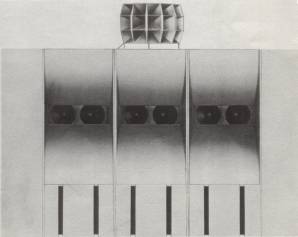
Horn systems are expensive to manufacture. Quality compression drivers are machined to exact tolerances within microns. Unfortunately today, selling is driven by marketing not by consumer understanding. Marketing profit can represent 80-90% of product cost. Cost cutting in manufacture relates to errors that magnify acoustical distortion within the music. Many senior engineers have expressed disgust of these practices. This text honours the original engineers who's love of music and acoustic technology stood above ego and personal gain. This text is also a contradiction to much of the present marketing hype and to those whose identities are attached to brand names, and model numbers.
A horn encapsulates the air in front of the speaker (driver). The vibrating air is focused forward at higher efficiency. To achieve this, the horn must turn smoothly through 90deg (exponential). Air cannot slip sideways, therefore air mass (radiation resistance) to the speaker (driver) is constant. With no horn, the cone movement increases 4 times for each octave decrease including a widening of dispersion. With a horn the cone (diaphragm) movement is reduced.
The 3 octave rule for horns
In theory, to achieve maximum efficiency, horn dimension should be 1 wave-length long and 1 wave-length in mouth circumference at the lowest frequency. At 3 octaves higher the wavelengths are 1/10 of horn size and too small for the horn to direct them. These small wave-lengths bounce around inside the horn chaotically. It is essential to rescale a smaller horn for the next 3 octaves. Long horns are for low frequencies. Short horns are for high frequencies. Saxophones Trumpets French horns Tubas Etc obey this rule. There is no such thing in physics as long-throw or short-throw horns. These irresponsible marketing terms loosely refer to horn directivity.
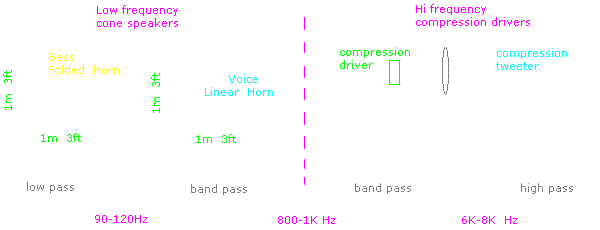
Below 1Khz approx, special cone speakers are used for horns. These speakers should have a very high BL (extra large magnet and voice coil) and much stronger cones than would be normally used for a standard front loaded speaker cabinet. Above 1Khz, special compression drivers are used with horns. There are other unique variations of horn and driver arrangements available, not described in this text.
Horns for Low frequencies use Cone Speakers
Low frequency horns using cone speakers can be 1/2 but not less than 1/4 wave-length at the lowest frequency, with reduced efficiency. 40Hz wave-length is 8m / 24ft It is not practical to make a bass horn this size so the horn is shortened (truncated) to 1/4 wavelength 2m / 6ft. Bass bin horns can be folded to control size. Made in sections and grouped to form a single bin.
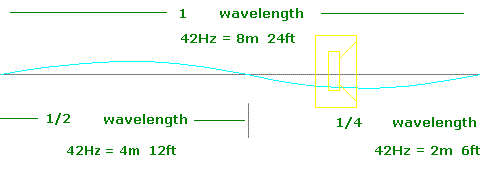
With no horn the cone movement increases 4 times for each octave decrease. With a horn the speaker cone movement is reduced to 2. Efficiency increase is approx 4 times (+6dB). In theory, power to the speaker can also be doubled (+3dB). Total advantage is approx +10dB with increased directivity. Designing for bass horns is always a compromise. The length of the horn is the most difficult to achieve if the bass horn has to be portable and fit within a given space. The compromise is to keep to the correct flare rate, and mouth size. Bass horns should be grouped to obtain the correct mouth size.

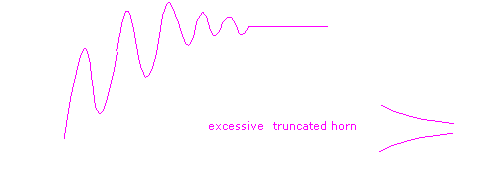
Many (if not most) bass horns are smaller than they should be and sound bonky. Often only a single bass horn is used. Length and the mouth size is compromised. Application for Techno music is the greatest offender. Rarely do Techno sound systems deliver bass below 60Hz.


